Construction of roads and railways leads the sector
The final results of the 2010 Annual Survey of Philippine Business and Industry showed that there were 1,464 establishments in the formal sector of the economy engaged in construction activities (Table 1).
Construction of roads and railways led the sector in terms of the number of establishments with 674 or 46.0 percent of the total. Non-residential building constructions ranked a far second with 211 establishments (14.4%), followed by residential building constructions with 184 establishments (12.6%) and electrical installation with 182 establishments (12.4%). Figure 1 shows the percentage distribution of all construction establishments by industry sub-class in 2010.

Construction of roads and railways employs majority of workers
Construction establishments employed a total of 138,704 workers in 2010. Paid employees constituted 138,284 workers or 99.7 percent of the total, while the remaining 420 workers or 0.3 percent were working owners and unpaid workers (Table 1).
By industry, construction of roads and railways, having the highest number of establishments, hired the majority of workers with 59,942 (43.2%). This was followed by non-residential building constructions with 37,860 workers (27.3%) and electrical installation with 16,588 workers (12.0%). Residential building constructions, which placed third in terms of number of establishments, hired only 7,393 workers (5.3%). Figure 2 displays the distribution of employment for all construction establishments by industry sub-class in 2010.
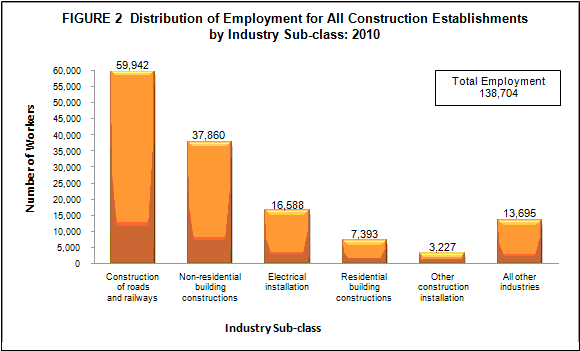
The average number of workers for the sector was recorded at 95 per establishment.
Industrywise, non-residential building constructions topped the sector with 179 workers per establishment (Table 2). Other industries that exceeded the national average in terms of average number of workers per establishment were as follows:
- Construction of other civil engineering projects, 144 workers
- Plumbing, heat and air-conditioning installation, 129 workers
Employees of construction of utility projects are the highest paid
Compensation paid by all construction establishments to its employees in 2010 amounted to PHP21.2 billion, translating to an average annual remuneration of PHP153,505 per employee (Table 2).
Employees of construction of utility projects were the highest paid with an average annual pay of PHP387,012. Moreover, employees in the following industries received average annual compensation higher than the national average:
- Electrical installation, PHP 187,815
- Other construction installation, PHP172,781
- Plumbing, heat and air-conditioning installation, PHP171, 433
- Non-residential building constructions, PHP170,545
Figure 3 displays the average annual compensation of employees for all construction establishments by industry sub-class in 2010.
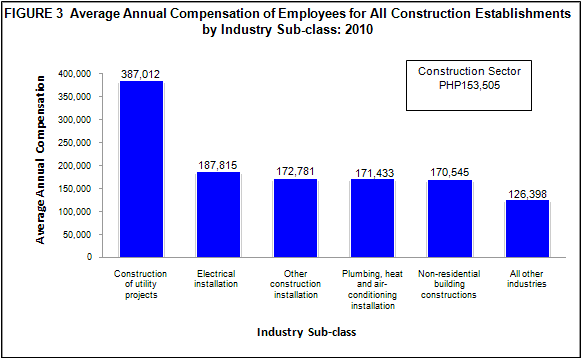
Total value of output reaches PHP172.6 billion
Total value of output in 2010 produced by all construction establishments was estimated at PHP172.6 billion (Table 1).
By industry, the highest value of output was generated by construction of roads and railways worth PHP70.7 billion accounting for 41.0 percent of total, followed by non-residential building constructions with PHP54.9 billion (31.8%). Electrical installation with output value of PHP16.0 billion (9.3%) and residential building constructions with PHP12.2 billion (7.0%) ranked third and fourth, respectively. Figure 4 displays the percentage distribution of value of output for all construction establishments by industry sub-class in 2010.
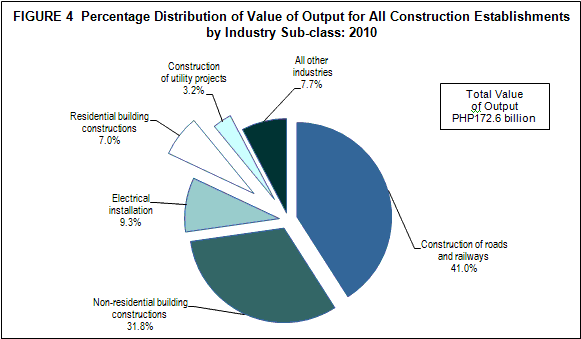
Construction sector spends PHP140.9 billion
Total cost, excluding compensation, incurred by all construction establishments in 2010 reached PHP140.9 billion.
Combined cost of the top two industries accounted for about three-fourths of the total cost, construction of roads and railways with PHP60.7 billion (43.1%) and non-residential building constructions with PHP44.5 billion (31.6%). Electrical installation incurred PHP11.6 billion (8.3%) and residential building constructions, PHP10.4 billion (7.4%), in their business operations (Table 1).
Plumbing, heat and air-conditioning installation records highest returns
The ratio of total revenue to total cost was recorded at 1.25 for the sector, which means that for every peso spent PHP1.25 was realized in terms of revenue (Table 2).
Among industries, plumbing, heat and air-conditioning installation recorded the highest revenue per peso cost of 1.88. Painting and related work placed second with a 1.82 ratio. Other industries with revenue per peso cost higher than the sector’s ratio were as follows:
- Construction of utility projects,1.56
- Electrical installation,1.42
- Other construction installation,1.41
- Other specialized construction activities, 1.40
- Site preparation, 1.28
Construction of roads and railways generates highest value added
Total value added generated by all construction establishments was estimated at PHP42.0 billion (Table 1).
Industrywise, construction of roads and railways accounted for the biggest share to total value added amounting to PHP15.0 billion or 35.6 percent. Non-residential building constructions was the next highest contributor with PHP13.1 billion (31.1%) followed by electrical installation with PHP5.4 billion (12.7%).
Construction of utility projects records highest labor productivity
Labor productivity, defined as the ratio of value added to total employment, was estimated at PHP303.1 thousand for the construction sector.
The highest labor productivity was recorded by construction of utility projects with PHP700.1 thousand (Table 2). Other industries that surpassed the national average in terms of labor productivity were as follows:
- Other specialized construction activities, PHP368.3 thousand
- Residential (dwelling) building constructions, PHP355.2 thousand
- Non-residential building constructions, PHP345.6 thousand
- Plumbing, heat and air-conditioning installation, PHP342.8 thousand
- Electrical installation, PHP323.0 thousand
- Construction of other engineering projects, PHP320.6 thousand
Figure 5 shows the labor productivity for all construction establishments by industry sub-class in 2010.

Gross addition to tangible fixed assets reaches PHP3.0 billion
Gross addition to tangible fixed assets, defined as capital expenditures less sale of tangible fixed assets, reached PHP3.0 billion.
Construction of roads and railways acquired the highest addition to its tangible fixed assets amounting to PHP1.2 billion or 39.1 percent of total. Non-residential building constructions ranked second with addition to tangible fixed assets worth PHP0.9 billion (31.3%) while electrical installation with PHP0.3 billion (9.4%) placed third (Table 1).
Subsidies
The construction sector did not receive any subsidy from the government in 2010.
TECHNICAL NOTES
Introduction
This Special Release presents the final results of the 2010 Annual Survey of Philippine Business and Industry (ASPBI) for the Construction sector.
The 2010 ASPBI is one of the designated statistical activities of the National Statistics Office (NSO) with the objective of providing key measures on the levels, structure, trends and performance of economic activities in the country. As such, the survey generates the most critical and essential statistics required for economic planning and policies. It was conducted in April 2011 with year 2010 as the reference period of data, except for employment which is as of November 15, 2010.
The 2009 Philippine Standard Industrial Classification (PSIC) was adopted for the first time in this survey. This is the latest version of the classification of industries in the country which conforms with the International Standard Industrial Classification Revision 4 prescribed by the United Nations.
Data are presented at the industry sub-class or 5-digit 2009 PSIC, national level.
Legal Authority
The conduct of the ASPBI is governed by legislative acts and presidential directives, mainly Commonwealth Act No. 591 which was approved on August 19,1940. Other legislative acts are:
- Presidential Decree No. 418
- Executive Order No. 121
- Executive Order No. 352
- Executive Order No. 5
Scope and Coverage
The 2010 ASPBI covered establishments engaged in 18 economic sectors classified under the 2009 PSIC, namely:
- Agriculture, Forestry and Fishing (A)
- Mining and Quarrying (B)
- Manufacturing (C)
- Electricity, Gas, Steam, and Air Conditioning Supply (D)
- Water Supply; Sewerage, Waste Management and Remediation Activities (E)
- Construction (F)
- Wholesale and Retail Trade; Repair and Maintenance of Motor Vehicles, Motorcycles (G)
- Transportation and Storage (H)
- Accommodation and Food service activities (I)
- Information and Communication (J)
- Financial and Insurance Activities (K)
- Real Estate Activities (L)
- Professional, Scientific and Technical Activities (M)
- Administrative and Support Service Activities (N)
- Education (P)
- Human Health and Social Work Activities (Q)
- Arts, Entertainment and Recreation (R)
- Other Service Activities (S)
The survey was confined to the formal sector of the economy, which consists of the following:
- Corporations and partnership
- Cooperatives and foundations
- Single proprietorship with employment of 10 and over
- Single proprietorships with branches
Unit of Enumeration
Like all other establishments surveys conducted by the NSO, the 2010 ASPBI unit of enumeration is the establishment. The establishment is defined as an economic unit under a single ownership or control which engages in one or predominantly one kind of activity at a single fixed location.
To take into account the organization and record keeping practices of construction sector by making the single location and activity criteria more flexible, the operational definition of establishments is “the unit that is engaged in the production of the most homogeneous group of goods and services, usually at one location, but sometimes over a wider area, for which separate records are available that can provide data concerning the production of these goods and services and materials, labor and physical resources used in this production.”
Sampling Design
The 2010 ASPBI used stratified systematic sampling with five-digit PSIC serving as first stratification variable and TE as the second stratification variable.
Estimation Procedure
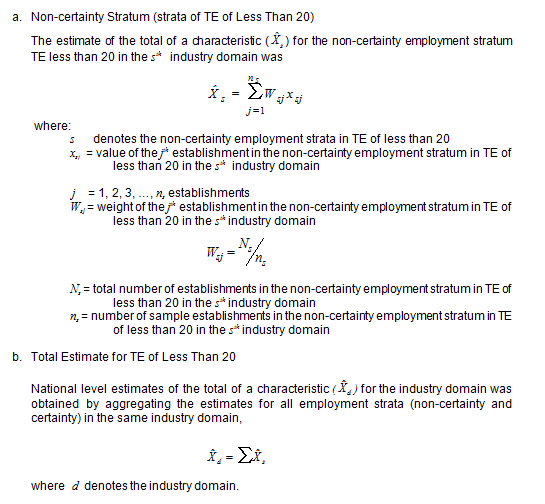

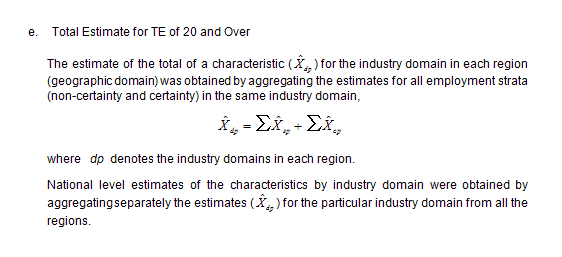
Response Rate
The response rate is 95.7 percent (597 out of 624 establishments). These include receipts of "good" questionnaires, partially accomplished questionnaires, reports of closed, moved out or out of scope establishments.
Concepts and Definitions of Terms
Economic activity is the establishment’s source of income. If the establishment is engaged in several activities, its main economic activity is that which earns the biggest income or revenue.
Total employment is the number of persons who worked in for the establishment as of November 15, 2010.
Paid employees are all persons working in the establishment and receiving pay, as well as those working away from the establishment paid by and under the control of the establishment. Included are all employees on sick leave, paid vacation or holiday. Excluded are consultants, home workers, receiving pure commissions only, and workers on indefinite leave.
Compensation includes salaries and wages, separation/retirement/terminal pay, gratuities, and payments made by the employer in behalf of the employees such as contribution to SSS/GSIS, ECC, PhilHealth, Pag-ibig, etc.
Revenue includes cash received and receivables for goods/products and by-products sold and services rendered. Valuation is at producer prices (ex-establishment), net of discounts, and allowances, including duties and taxes but excluding subsidies.
Cost refers to all expenses incurred during the year whether paid or payable. Valuation is at purchaser prices including taxes and other charges, net of rebates, returns and allowances. Goods and services received by the establishment from other establishments of the same enterprise are valued as though purchased.
Intermediate cost refers to expenses incurred in the production of goods such as materials and supplies purchased, fuels purchased, electricity purchased and industrial services done by others plus beginning inventory of materials, supplies and fuels less ending inventory of materials, supplies and fuels.
Value added is gross output less intermediate cost. Gross output for the construction sector is value of output plus non-industrial services done for others (except rent income from land). Intermediate input is intermediate cost plus non-industrial services done by others (except rent expense for land) and other costs.
Value of output represents the sum of the receipts from value of domestic construction put in place, net income from construction activities abroad, industrial services done for others, value of products manufactured and goods sold in the same condition as purchased less the cost of goods sold; and value of fixed assets produced on own account and change in inventories of construction-in-progress, finished products and work-in-progress.
Gross addition to tangible fixed assets is equal to capital expenditures less sale of fixed assets, including land.
Change in inventories is equivalent to the value of inventories at the end of the year less the value of inventories at the beginning of the year.
Inventories refer to the stock of goods owned by and under the control of the establishment as of a fixed date, regardless of where the stocks are located. Valuation is at current replacement cost in purchaser prices. Replacement cost is the cost of an item in terms of its present price rather than its original cost.
Subsidies are all special grants in the form of financial assistance or tax exemption or tax privilege given by the government to aid and develop an industry.
